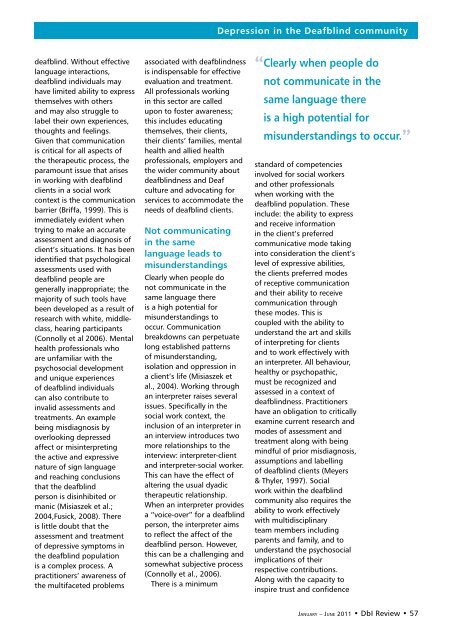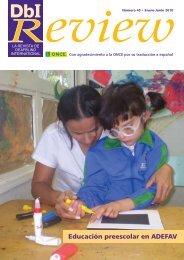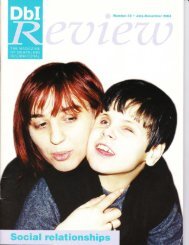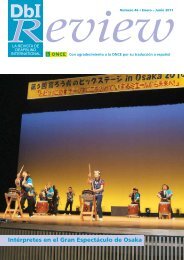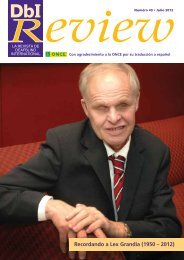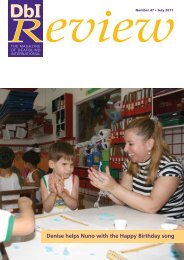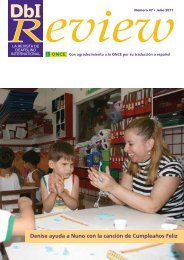Performers at Osaka's Big Stage - Deafblind International
Performers at Osaka's Big Stage - Deafblind International
Performers at Osaka's Big Stage - Deafblind International
Create successful ePaper yourself
Turn your PDF publications into a flip-book with our unique Google optimized e-Paper software.
Depression in the <strong>Deafblind</strong> communitydeafblind. Without effectivelanguage interactions,deafblind individuals mayhave limited ability to expressthemselves with othersand may also struggle tolabel their own experiences,thoughts and feelings.Given th<strong>at</strong> communic<strong>at</strong>ionis critical for all aspects ofthe therapeutic process, theparamount issue th<strong>at</strong> arisesin working with deafblindclients in a social workcontext is the communic<strong>at</strong>ionbarrier (Briffa, 1999). This isimmedi<strong>at</strong>ely evident whentrying to make an accur<strong>at</strong>eassessment and diagnosis ofclient’s situ<strong>at</strong>ions. It has beenidentified th<strong>at</strong> psychologicalassessments used withdeafblind people aregenerally inappropri<strong>at</strong>e; themajority of such tools havebeen developed as a result ofresearch with white, middleclass,hearing participants(Connolly et al 2006). Mentalhealth professionals whoare unfamiliar with thepsychosocial developmentand unique experiencesof deafblind individualscan also contribute toinvalid assessments andtre<strong>at</strong>ments. An examplebeing misdiagnosis byoverlooking depressedaffect or misinterpretingthe active and expressiven<strong>at</strong>ure of sign languageand reaching conclusionsth<strong>at</strong> the deafblindperson is disinhibited ormanic (Misiaszek et al.;2004,Fusick, 2008). Thereis little doubt th<strong>at</strong> theassessment and tre<strong>at</strong>mentof depressive symptoms inthe deafblind popul<strong>at</strong>ionis a complex process. Apractitioners’ awareness ofthe multifaceted problemsassoci<strong>at</strong>ed with deafblindnessis indispensable for effectiveevalu<strong>at</strong>ion and tre<strong>at</strong>ment.All professionals workingin this sector are calledupon to foster awareness;this includes educ<strong>at</strong>ingthemselves, their clients,their clients’ families, mentalhealth and allied healthprofessionals, employers andthe wider community aboutdeafblindness and Deafculture and advoc<strong>at</strong>ing forservices to accommod<strong>at</strong>e theneeds of deafblind clients.Not communic<strong>at</strong>ingin the samelanguage leads tomisunderstandingsClearly when people donot communic<strong>at</strong>e in thesame language thereis a high potential formisunderstandings tooccur. Communic<strong>at</strong>ionbreakdowns can perpetu<strong>at</strong>elong established p<strong>at</strong>ternsof misunderstanding,isol<strong>at</strong>ion and oppression ina client’s life (Misiaszek etal., 2004). Working throughan interpreter raises severalissues. Specifically in thesocial work context, theinclusion of an interpreter inan interview introduces twomore rel<strong>at</strong>ionships to theinterview: interpreter-clientand interpreter-social worker.This can have the effect ofaltering the usual dyadictherapeutic rel<strong>at</strong>ionship.When an interpreter providesa “voice-over” for a deafblindperson, the interpreter aimsto reflect the affect of thedeafblind person. However,this can be a challenging andsomewh<strong>at</strong> subjective process(Connolly et al., 2006).There is a minimum“ Clearly when people donot communic<strong>at</strong>e in thesame language thereis a high potential formisunderstandings to occur. ”standard of competenciesinvolved for social workersand other professionalswhen working with thedeafblind popul<strong>at</strong>ion. Theseinclude: the ability to expressand receive inform<strong>at</strong>ionin the client’s preferredcommunic<strong>at</strong>ive mode takinginto consider<strong>at</strong>ion the client’slevel of expressive abilities,the clients preferred modesof receptive communic<strong>at</strong>ionand their ability to receivecommunic<strong>at</strong>ion throughthese modes. This iscoupled with the ability tounderstand the art and skillsof interpreting for clientsand to work effectively withan interpreter. All behaviour,healthy or psychop<strong>at</strong>hic,must be recognized andassessed in a context ofdeafblindness. Practitionershave an oblig<strong>at</strong>ion to criticallyexamine current research andmodes of assessment andtre<strong>at</strong>ment along with beingmindful of prior misdiagnosis,assumptions and labellingof deafblind clients (Meyers& Thyler, 1997). Socialwork within the deafblindcommunity also requires theability to work effectivelywith multidisciplinaryteam members includingparents and family, and tounderstand the psychosocialimplic<strong>at</strong>ions of theirrespective contributions.Along with the capacity toinspire trust and confidenceJan u a r y – Ju n e 2011 • DbI Review • 57


